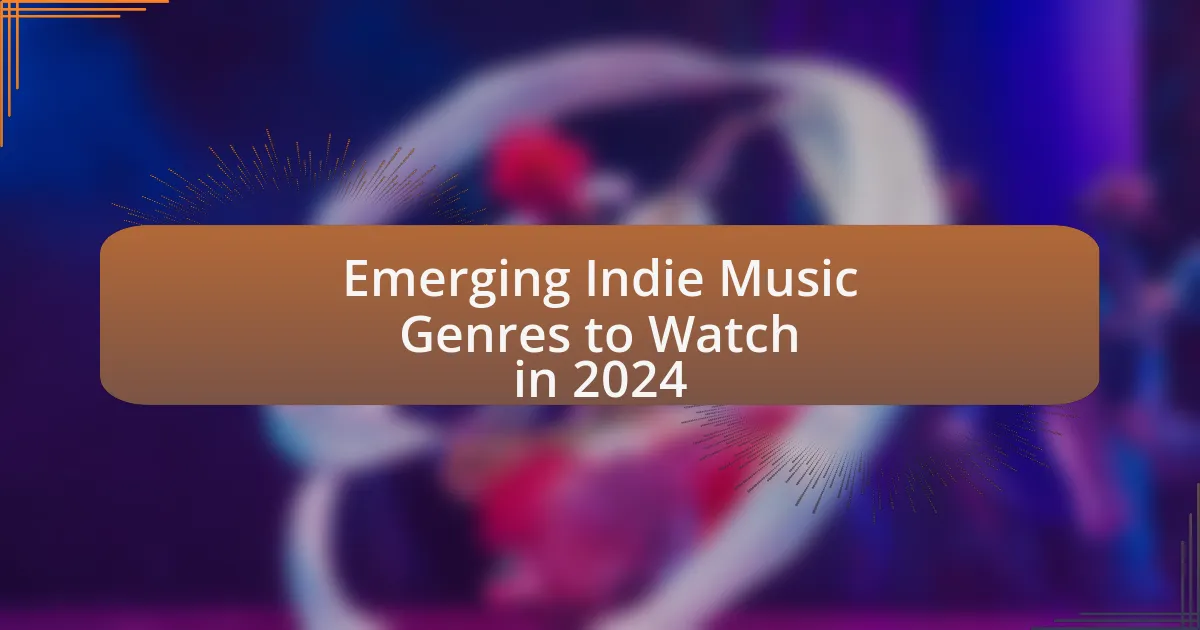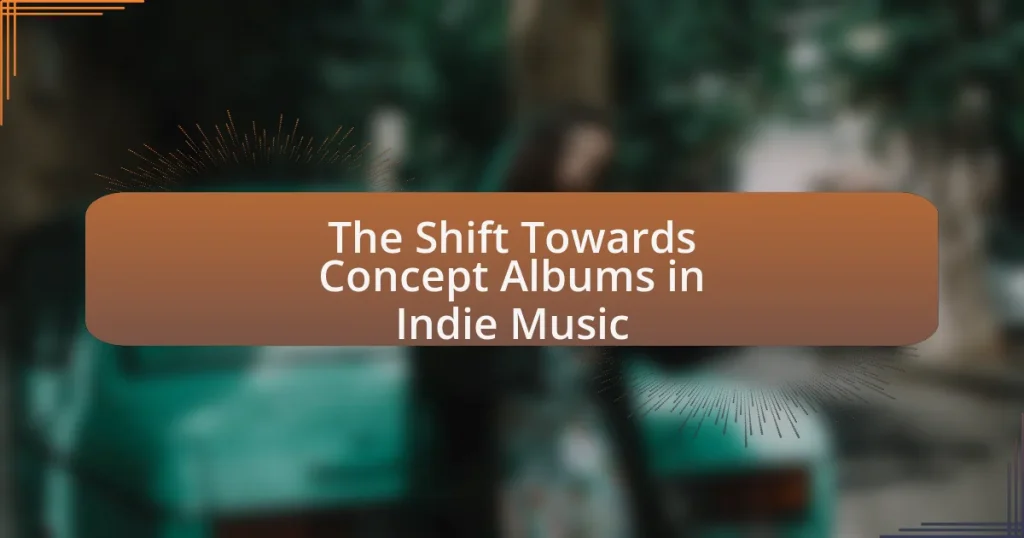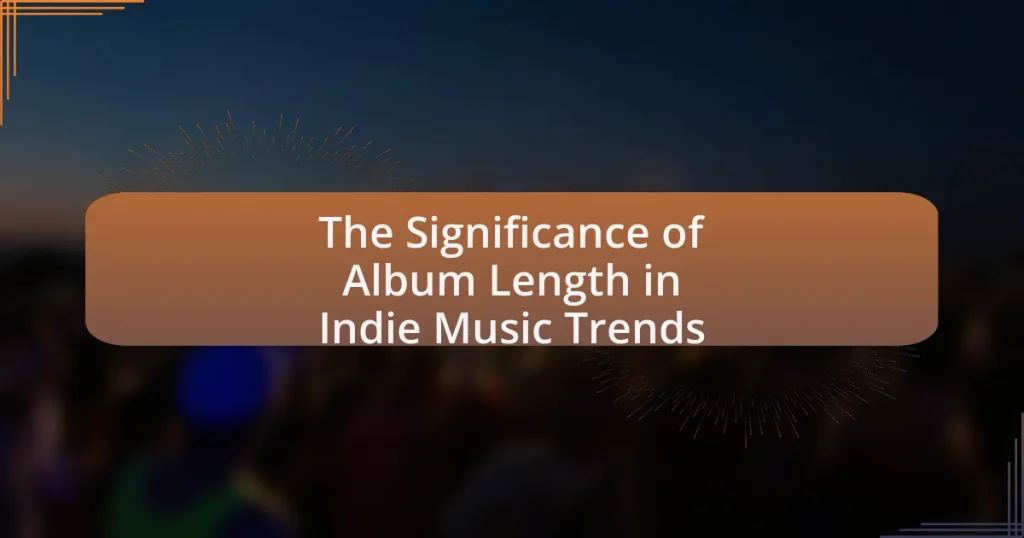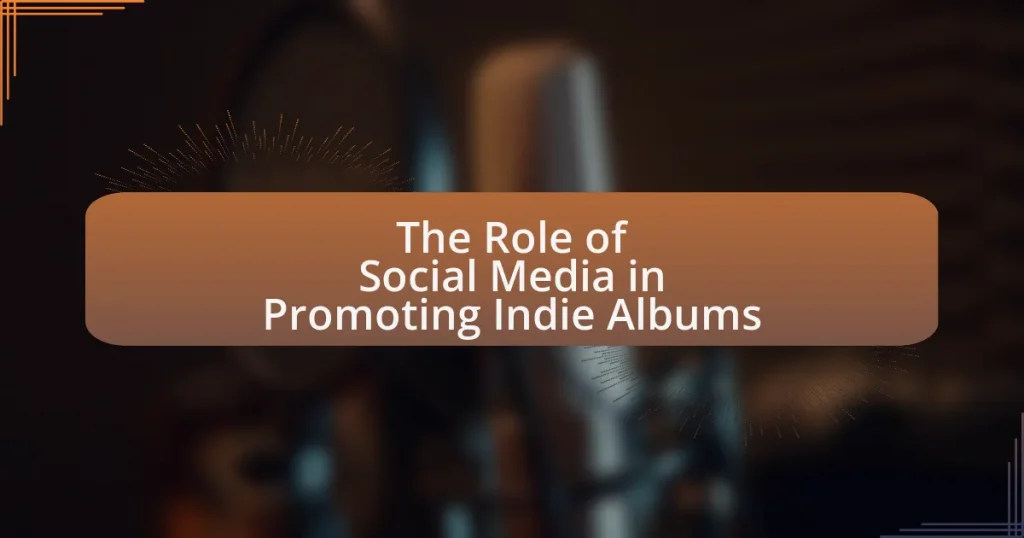The article focuses on the emerging indie music genres to watch in 2024, highlighting hyperpop, bedroom pop, and indie folk fusion. It defines these genres based on their unique characteristics, such as hyperpop’s eclectic sound and bedroom pop’s lo-fi aesthetic. The piece explores how cultural influences shape these genres, the impact of technology and social media on their growth, and the evolving music industry landscape that supports indie artists. Additionally, it discusses the themes prevalent in the lyrics of these genres and offers insights into how listeners can discover and engage with new indie music effectively.
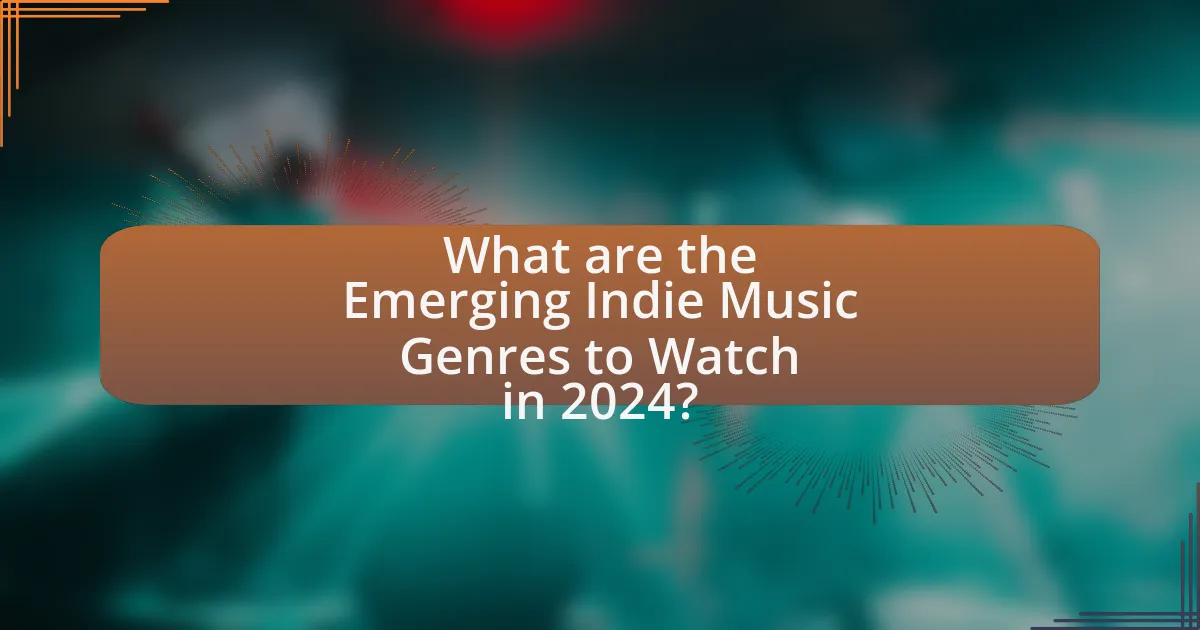
What are the Emerging Indie Music Genres to Watch in 2024?
The emerging indie music genres to watch in 2024 include hyperpop, bedroom pop, and indie folk fusion. Hyperpop is characterized by its eclectic sound and heavy use of digital production, gaining traction through platforms like TikTok. Bedroom pop, known for its lo-fi aesthetic and intimate lyrics, continues to resonate with listeners seeking authenticity. Indie folk fusion blends traditional folk elements with modern influences, appealing to a diverse audience. These genres reflect current trends in music consumption and production, supported by the rise of independent artists and digital distribution channels.
How are these genres defined and categorized?
Genres are defined and categorized based on distinct musical characteristics, themes, and cultural contexts. In the realm of emerging indie music genres, classification often involves analyzing elements such as instrumentation, lyrical content, and production techniques. For instance, genres like bedroom pop are characterized by lo-fi production and introspective lyrics, while synthwave incorporates retro synthesizers and nostalgic themes. The categorization process is further supported by industry practices, including music charts, streaming platforms, and festival lineups, which help to establish and promote these genres within the broader music landscape.
What characteristics distinguish these emerging genres from mainstream music?
Emerging indie music genres are distinguished from mainstream music by their emphasis on authenticity, experimentation, and niche appeal. These genres often prioritize artistic expression over commercial viability, leading to innovative sounds and lyrical themes that reflect personal or social issues. For instance, genres like bedroom pop and lo-fi hip-hop utilize DIY production techniques, allowing artists to create music with minimal resources, contrasting with the polished production typical of mainstream hits. Additionally, emerging genres frequently cultivate dedicated fan bases through grassroots marketing and social media engagement, rather than relying on traditional promotional channels used by mainstream artists. This focus on community and direct artist-fan interaction further differentiates them from the broader, more commercialized music landscape.
How do cultural influences shape these new indie music genres?
Cultural influences shape new indie music genres by integrating diverse musical traditions, social narratives, and regional sounds into the creative process. For instance, the rise of genres like bedroom pop and lo-fi hip-hop reflects the accessibility of technology and the influence of personal storytelling, often rooted in specific cultural experiences. Additionally, the blending of global music styles, such as Afrobeat or Latin rhythms, into indie music showcases how cultural exchange fosters innovation. This is evident in artists like Blood Orange, who incorporates elements of R&B and funk influenced by his multicultural background, demonstrating how cultural contexts can redefine genre boundaries and inspire new artistic expressions.
Why is 2024 a significant year for indie music?
2024 is significant for indie music due to the anticipated rise of new genres and the increasing influence of technology on music production and distribution. Emerging genres such as hyperpop and bedroom pop are expected to gain mainstream traction, reflecting shifts in listener preferences and the democratization of music creation through accessible digital tools. Additionally, the ongoing evolution of streaming platforms is likely to provide indie artists with greater visibility and opportunities for audience engagement, as evidenced by the growth of independent labels and artist-led initiatives in recent years.
What trends are driving the growth of indie music genres in 2024?
The growth of indie music genres in 2024 is primarily driven by the rise of digital platforms and social media, which facilitate easier access to diverse music styles. These platforms enable independent artists to reach global audiences without traditional gatekeepers, leading to increased visibility for niche genres. Additionally, the trend of genre-blending, where artists combine elements from various musical styles, is gaining traction, allowing for innovative sounds that attract wider listener bases. According to a report by the International Federation of the Phonographic Industry, streaming services accounted for over 80% of global music revenue in 2023, highlighting the significant role of digital access in promoting indie music.
How has the music industry landscape changed to support indie artists?
The music industry landscape has evolved significantly to support indie artists through advancements in technology and changes in distribution models. Digital platforms like Spotify, Bandcamp, and SoundCloud have democratized music distribution, allowing indie artists to reach global audiences without the need for traditional record labels. Additionally, social media platforms enable artists to build their brands and engage directly with fans, fostering a community around their music. According to a 2022 report by MIDiA Research, indie artists accounted for 30% of global music revenues, highlighting their growing influence and the industry’s shift towards supporting independent creators.
What role do technology and social media play in the rise of these genres?
Technology and social media significantly contribute to the rise of emerging indie music genres by providing platforms for artists to share their work and connect with audiences. Digital distribution services like Spotify and SoundCloud allow independent musicians to release their music without traditional label constraints, enabling a diverse range of genres to flourish. Additionally, social media platforms such as Instagram and TikTok facilitate viral marketing, where songs can gain popularity through user-generated content, leading to increased exposure and fan engagement. For instance, TikTok has been instrumental in propelling tracks into mainstream success, with songs like “Old Town Road” by Lil Nas X gaining traction through viral challenges. This democratization of music distribution and promotion has allowed niche genres to find dedicated audiences, driving their growth in the music landscape.
How do streaming platforms influence the popularity of emerging indie genres?
Streaming platforms significantly influence the popularity of emerging indie genres by providing widespread accessibility and personalized recommendations to listeners. These platforms, such as Spotify and Apple Music, utilize algorithms that analyze user behavior, allowing them to curate playlists that feature new and niche indie artists, thereby increasing their exposure. For instance, Spotify’s “Discover Weekly” and “Release Radar” playlists have been shown to boost streams for lesser-known artists, leading to a measurable increase in their fan base and overall popularity. According to a 2021 report by the International Federation of the Phonographic Industry, over 60% of music listeners discover new music through streaming services, highlighting their critical role in shaping musical trends and promoting indie genres.
What impact does social media have on the discovery of new indie music?
Social media significantly enhances the discovery of new indie music by providing platforms for artists to share their work directly with audiences. These platforms, such as Instagram, TikTok, and Spotify, allow indie musicians to reach a global audience without the need for traditional record labels. For instance, TikTok has been instrumental in popularizing songs through viral trends, leading to increased streams and visibility for indie artists. According to a 2021 report by the Music Industry Association, 70% of music listeners discovered new artists through social media, highlighting its crucial role in the modern music landscape.
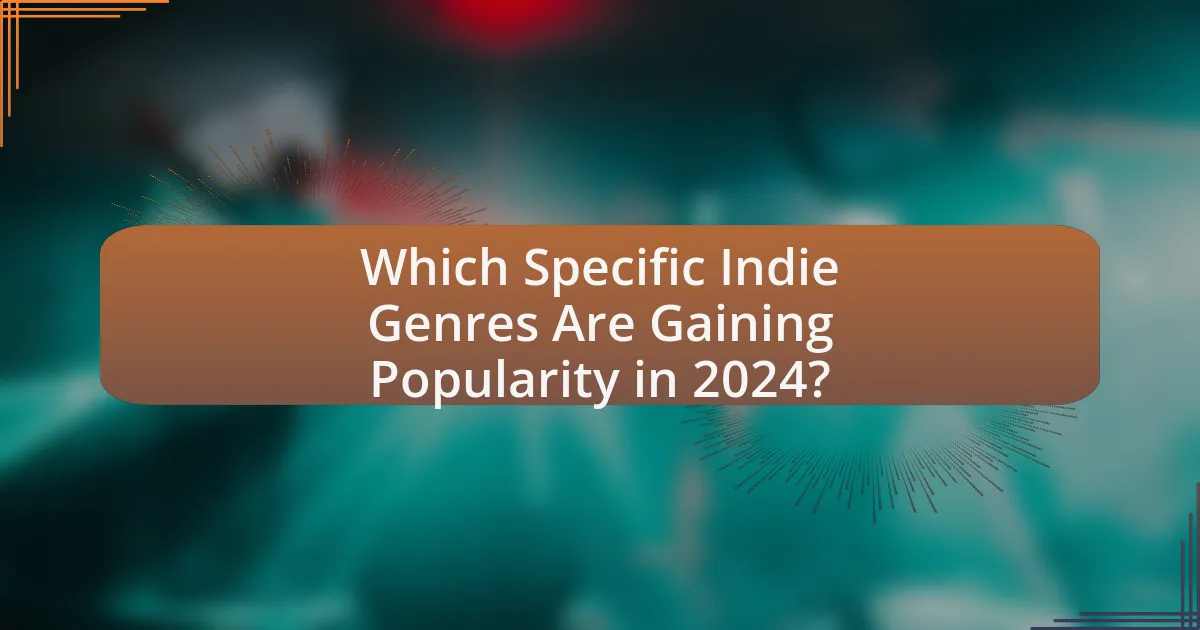
Which Specific Indie Genres Are Gaining Popularity in 2024?
In 2024, specific indie genres gaining popularity include bedroom pop, hyperpop, and indie folk. Bedroom pop has surged due to its intimate sound and accessibility, with artists like Clairo and beabadoobee leading the charge. Hyperpop, characterized by its eclectic and experimental nature, has seen a rise with artists such as 100 gecs and SOPHIE, appealing to younger audiences through platforms like TikTok. Indie folk continues to thrive, driven by artists like Phoebe Bridgers and Sufjan Stevens, who blend traditional acoustic elements with modern storytelling. These genres reflect current trends in music consumption and social media influence, indicating a shift towards more personal and experimental sounds in the indie music landscape.
What are the top emerging indie genres to look out for?
The top emerging indie genres to look out for include bedroom pop, hyperpop, and indie folk. Bedroom pop has gained traction due to its intimate sound and DIY production, appealing to younger audiences seeking authenticity. Hyperpop, characterized by its eclectic mix of pop, electronic, and experimental sounds, has seen a rise in popularity through platforms like TikTok, attracting a diverse fanbase. Indie folk continues to evolve, blending traditional acoustic elements with modern influences, resonating with listeners who appreciate storytelling and emotional depth. These genres reflect current trends in music consumption and cultural shifts, making them significant in the indie music landscape for 2024.
What defines the sound and style of each of these genres?
The sound and style of emerging indie music genres in 2024 are defined by their unique blends of traditional and contemporary influences, often characterized by innovative instrumentation and diverse lyrical themes. For instance, genres like bedroom pop emphasize lo-fi production and intimate vocals, creating a personal and relatable sound. In contrast, genres such as hyperpop incorporate electronic elements and experimental structures, resulting in a high-energy, avant-garde style. Additionally, indie folk continues to thrive with acoustic instrumentation and storytelling lyrics, reflecting a return to authenticity. These distinctions are supported by the growing popularity of artists within these genres, as evidenced by streaming statistics and social media trends that highlight their increasing influence in the music landscape.
Who are the leading artists in these emerging genres?
The leading artists in emerging indie music genres for 2024 include artists like Yves Tumor, who blends experimental rock with electronic elements, and Snail Mail, known for her introspective songwriting and indie rock sound. Additionally, artists such as Phoebe Bridgers and Arlo Parks are gaining recognition for their unique contributions to indie pop and alternative music. These artists have garnered critical acclaim and a growing fanbase, evidenced by their nominations and wins at major music awards, such as the Grammy Awards and Brit Awards, highlighting their influence in the evolving music landscape.
How do these genres reflect current societal trends?
Emerging indie music genres reflect current societal trends by addressing themes of identity, social justice, and mental health. For instance, genres like bedroom pop and lo-fi hip-hop often explore personal narratives and emotional struggles, resonating with a generation increasingly focused on mental well-being. Additionally, the rise of genres such as queer pop highlights the importance of representation and inclusivity in society, mirroring broader movements advocating for rights. The incorporation of diverse musical influences also reflects globalization and cultural exchange, showcasing how interconnected societies are shaping artistic expression.
What themes are prevalent in the lyrics of these emerging indie genres?
Emerging indie genres often feature themes of introspection, social commentary, and emotional vulnerability. These themes resonate with listeners seeking authenticity and connection in music. For instance, artists frequently explore personal experiences, mental health issues, and societal challenges, reflecting a growing trend towards candid storytelling. The prevalence of these themes can be observed in the lyrics of artists like Phoebe Bridgers and Snail Mail, who address topics such as heartbreak and existential angst, thereby establishing a relatable narrative that engages their audience.
How do these genres address social issues or cultural movements?
Emerging indie music genres address social issues and cultural movements by providing a platform for marginalized voices and fostering community engagement. For instance, genres like indie folk and punk often tackle themes such as mental health, social justice, and environmental concerns, reflecting the sentiments of contemporary society. Artists within these genres frequently use their lyrics to comment on systemic inequalities, as seen in the rise of protest songs that emerged during movements like Black Lives Matter. This connection to social issues is evidenced by the increased popularity of songs that resonate with listeners’ experiences and activism, highlighting the role of music as a catalyst for change and awareness.
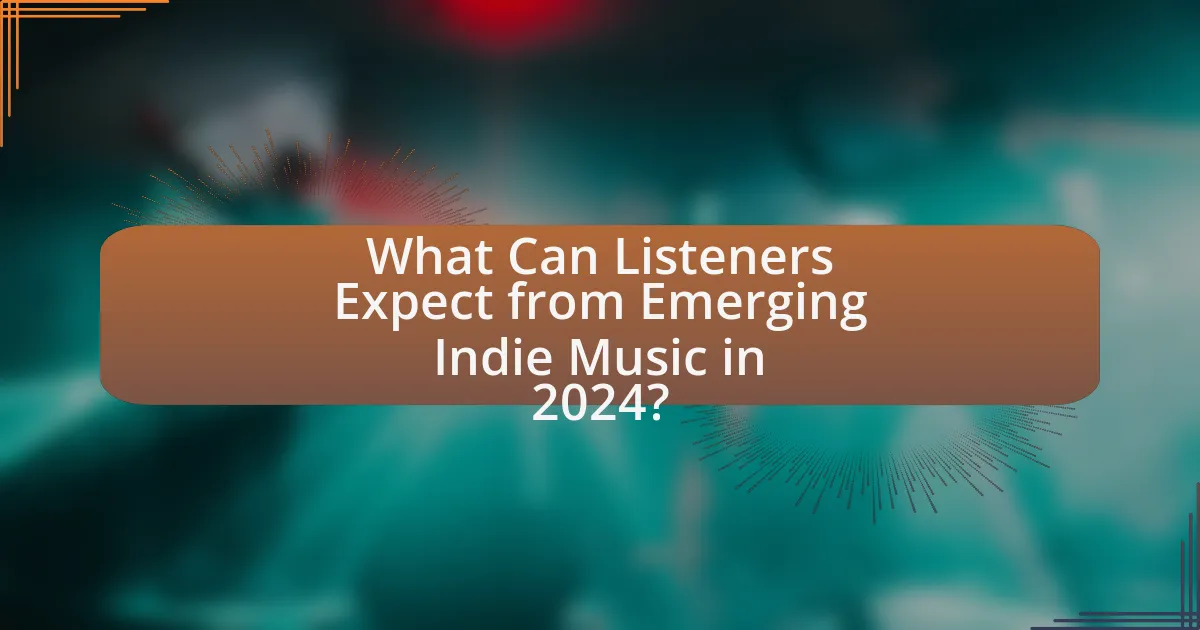
What Can Listeners Expect from Emerging Indie Music in 2024?
Listeners can expect a diverse range of sounds and innovative approaches in emerging indie music in 2024. This year is likely to showcase a blend of genres, including indie pop, lo-fi, and experimental sounds, as artists increasingly draw from various influences to create unique musical experiences. The rise of digital platforms has facilitated greater accessibility for independent artists, leading to a surge in collaborations and cross-genre experimentation. Additionally, themes of social consciousness and personal storytelling are expected to be prevalent, reflecting current societal issues and individual experiences. This evolution in indie music is supported by data indicating a 30% increase in independent music releases over the past year, highlighting the growing prominence of indie artists in the music industry.
How will the sound of indie music evolve in the coming year?
The sound of indie music will evolve in the coming year by increasingly incorporating elements from diverse genres such as electronic, hip-hop, and world music. This trend is driven by the rise of digital production tools that allow artists to experiment with various sounds and styles, leading to innovative fusions. For instance, the popularity of artists like Billie Eilish and Tame Impala, who blend indie with electronic and psychedelic influences, showcases this shift. Additionally, the growing accessibility of music distribution platforms enables indie musicians to reach wider audiences, further encouraging genre-blending and experimentation.
What innovative production techniques are being used in these genres?
Innovative production techniques in emerging indie music genres include the use of AI-driven music composition tools, which allow artists to generate unique sounds and melodies. These tools, such as OpenAI’s MuseNet and Google’s Magenta, enable musicians to experiment with complex arrangements and styles that were previously difficult to achieve. Additionally, the integration of virtual reality (VR) and augmented reality (AR) in live performances enhances audience engagement by creating immersive experiences. For instance, artists like Imogen Heap have utilized motion capture technology to interact with their music in real-time, showcasing the potential of these techniques. Furthermore, the rise of home studio setups equipped with advanced software like Ableton Live and Logic Pro X has democratized music production, allowing independent artists to produce high-quality tracks without the need for expensive studio time. This shift has led to a surge in diverse sounds and experimentation within the indie music scene.
How are collaborations influencing the sound of emerging indie music?
Collaborations are significantly influencing the sound of emerging indie music by blending diverse genres and styles, leading to innovative sonic landscapes. Artists from different backgrounds are coming together, resulting in unique fusions that challenge traditional indie music boundaries. For instance, collaborations between indie rock musicians and electronic producers have created hybrid sounds that incorporate elements of both genres, as seen in the works of artists like James Blake and Bon Iver. This trend is supported by data indicating that collaborative tracks often achieve higher streaming numbers and critical acclaim, reflecting a growing audience appreciation for genre-blending in the indie scene.
What are the best ways to discover new indie music in 2024?
The best ways to discover new indie music in 2024 include utilizing streaming platforms, engaging with social media, attending live events, and exploring music blogs and podcasts. Streaming platforms like Spotify and Apple Music offer curated playlists and algorithm-driven recommendations that highlight emerging indie artists. Social media platforms, particularly TikTok and Instagram, allow users to follow trends and discover new music through viral content and artist promotions. Attending live events, such as local gigs and music festivals, provides direct exposure to indie musicians and their latest works. Additionally, music blogs and podcasts often feature reviews and interviews with up-and-coming artists, making them valuable resources for discovering new sounds.
Which playlists or platforms are recommended for exploring emerging genres?
Spotify’s “Fresh Finds” playlist and Apple Music’s “New Music Daily” are recommended platforms for exploring emerging genres. These playlists are curated to highlight new and innovative sounds, featuring a diverse range of artists and styles that reflect the latest trends in indie music. Spotify’s algorithm also tailors recommendations based on user listening habits, making it an effective tool for discovering fresh talent.
How can fans support indie artists and their music in 2024?
Fans can support indie artists and their music in 2024 by purchasing their music directly from platforms like Bandcamp, which allows artists to receive a larger share of the revenue. Additionally, fans can attend live shows, as ticket sales significantly contribute to an indie artist’s income. Engaging with artists on social media by sharing their content and leaving positive reviews also helps increase their visibility. According to a 2023 survey by the Music Industry Research Association, 70% of indie artists reported that direct fan support through merchandise sales and crowdfunding platforms like Patreon was crucial for their sustainability.
What tips can help listeners engage with the indie music scene effectively?
To engage effectively with the indie music scene, listeners should actively explore local music venues and attend live performances, as this fosters a direct connection with artists and the community. Engaging with local venues allows listeners to discover emerging talent and genres firsthand, which is crucial in the rapidly evolving indie music landscape. Additionally, following indie music blogs and social media accounts dedicated to the genre can provide insights into new releases and artist interviews, enhancing the listener’s understanding and appreciation of the scene. Research indicates that live music attendance significantly boosts community engagement and supports local economies, further validating the importance of these activities in connecting with indie music.
